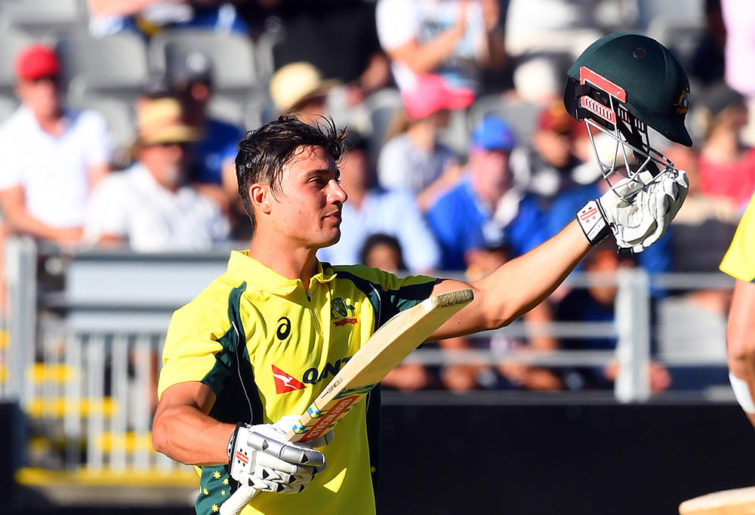At 2-0 down against a confident India, the trepidation that so characterised recent Australian ODI sides was noticeably absent last week.
There was a resoluteness in the side, a belief in their plan to beat India at home – one of world cricket’s toughest tasks.
“We know how close the two teams are,” Marcus Stoinis said assuredly after the narrow Nagpur loss. “Take your opportunities, put them under pressure and hopefully we win the next three.”
And so they did, in stunning fashion claiming a 3-2 series win in the early hours of Thursday morning.
Never before has Australia clawed back a 2-0 deficit, and in doing so broke a 26-month drought without an ODI series win. The Aussies haven’t so much turned a corner as screeched round a u-turn. They’re back, and world cricket has collectively sighed.

Marcus Stoinis might be getting a shot in the Test team. (AAP Image/SNPA, Ross Setford)
The past fortnight will naturally prove invaluable for Justin Langer’s side, on a number of fronts. First, and most importantly, Australia has rediscovered an ability to close out games and win in pressure situations.
Prior to this series, the side had won just two of its last 12 ODIs in a run of games littered with predictable, groundhog day performances. These were perhaps best typified during the back-to-back losses against England at home (4-1), then away (5-0).
During those series, the Aussies had no answer to the likes of Jason Roy, Jonny Bairstow and Jos Buttler. In India, however, Australia tempered India’s batting prowess. Shifts in momentum were clawed back, belief re-instilled with each broken partnership.
Concerted, disciplined bowling plans and a polished effort in the field were wholly evident. Cummins was predictably immense, Richardson continually impressive, and Zampa exuding the confidence of a frontline spinner.
This was comfortably his best set of performances at international level.
The second reason this series may prove crucial is the confidence Langer’s side will draw from not only their record chase in the fourth ODI, but the ability to claw back a 2-0 deficit.
Facing India away is one of world cricket’s toughest tasks, and in front of frenzied crowds Kohli’s side sense blood better than most. But the Aussies fought back in tough circumstances – a mental barrier they can draw on when things gets tough during the World Cup.
Australia has also, finally, shown it can match the scoring power of England and India, the world’s top two ODI sides.
In the last two years, those nations have regularly passed totals of 350, while Australia has scratched that mark on only its best of days. But a record chase of 359/6 off 47.5 overs in the fourth ODI, minus its two best batsmen, was monumental.
In fact, the third and fourth ODIs were the first time Australia had scored back-to-back 300+ totals in over two years. And while the sample size needs to increase should it seek to make a mark at the World Cup, the platform is there.
It’s worth noting, too, that Australia has only played the world’s best ODI sides in the last 18 months. Five of the last six series have been against either the aforementioned England (ranked no.1) and India (no.2), while the sixth was a three-game series against South Africa (no.4) earlier in the summer.
Irrespective of the questionable equity of Australia, India and England’s triopoly of the future tours program, the continual exposure to the world’s best is ideal preparation.
Questions have already turned to the makeup of Australia’s squad – and then, best XI – for the World Cup. Shaun Marsh, Australia’s premier ODI batsman in the last 12 months, has hit a dry spell at a most inopportune time.
Three weeks ago, the 35-year old likely had a Heathrow-bound flight booked for May, but scores of 16, 7 and 6 saw him surprisingly dropped for the fifth ODI.
Usman Khawaja (series top scorer with 383 runs at 76.6) and Peter Handscomb (236 at 47.2) have seemingly overtaken the West Australian after superb respective series, with the former’s purple patch raising interesting questions about Australia’s first-choice opening pair.
Ashton Turner’s match-winning performance in the fourth ODI alone could earn him a squad place, although it may prove hard to squeeze him into the best XI.

Ashton Turner of Australia bats during game four of the One Day International series between India and Australia at Punjab Cricket Association Stadium on March 10, 2019 in Mohali, India. (Photo by Robert Cianflone/Getty Images)
On a bowling front, Adam Zampa (11 wickets at 25.8) has firmed as Australia’s number one spin option, while Nathan Lyon is still expected to be in the squad. Pat Cummins’ (14 wickets at 15.7) brilliant performances with the new ball also raise another selection headache, bringing into question the role of vice-captain Josh Hazlewood.
Mitchell Starc is likely to have first use with Cummins, and Hazlewood might not squeeze into the XI as a first-change option.
Whatever the case, the upcoming series against Pakistan (beginning next Friday) gives fringe players the final opportunity to press their case before the April 23 squad deadline. With an eye-watering five games in just nine days, Langer is likely to rotate players.
The healthy competition for spots may just yield more success for the Aussies, the perfect tonic before a World Cup assault.






























































































